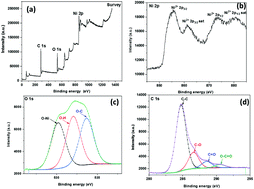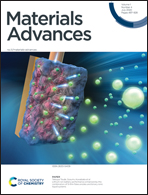Sucrose-derived carbon-coated nickel oxide (SDCC-NiO) as an electrode material for supercapacitor applications
Abstract
Sucrose-derived carbon-coated nickel oxide (SDCC-NiO) was successfully synthesized via a colloidal method. Nickel oxide and sucrose were used to synthesize SDCC-NiO, where sucrose worked as a soluble source of carbon in the process. Sucrose was converted into carbon during annealing in an inert atmosphere and coated on the surface of nickel particles. SDCC-NiO was characterized via Brunauer–Emmett–Teller (BET) method, X-ray diffraction (XRD), Raman spectroscopy, scanning electron microscopy (SEM), transmission electron microscopy (TEM), and X-ray photoelectron spectroscopy (XPS). The as-prepared SDCC-NiO was used as an electrode material. SDCC-NiO exhibited the maximum specific capacitance of 473 F g−1 at a scan rate of 5 mV s−1 in a 1 M KOH electrolyte with an energy density of 4.5 kW kg−1 at a current density of 15 A g−1.

- This article is part of the themed collection: Advances in Energy Materials


 Please wait while we load your content...
Please wait while we load your content...